MKT01760 Tourism Planning: A New Plan to Address GFC in Australia
VerifiedAdded on 2023/06/07
|20
|4359
|271
Report
AI Summary
This report outlines a proposed tourism plan for Australia designed to mitigate the impact of the Global Financial Crisis (GFC) and promote sustainable tourism. The plan acknowledges the Australian Trade and Investment Commission's aim to boost tourism and addresses the challenges posed by the GFC, including reduced tourist spending and economic downturns. The report delves into the background context of the GFC, exploring factors like credit crunches, financial crises, reduced industrial output, and the fall in GDP and USD value, further analysing its effect on Australian tourism. It emphasizes the need for a collaborative approach involving the Australian government, international bodies, business organizations, financial institutions, and tourists. The proposed plan adopts a systems approach and focuses on consultation, implementation, and review processes to strengthen Australia's tourism industry and ensure its resilience against economic challenges, while also aligning with international agreements and partnerships to diversify tourism revenue streams.
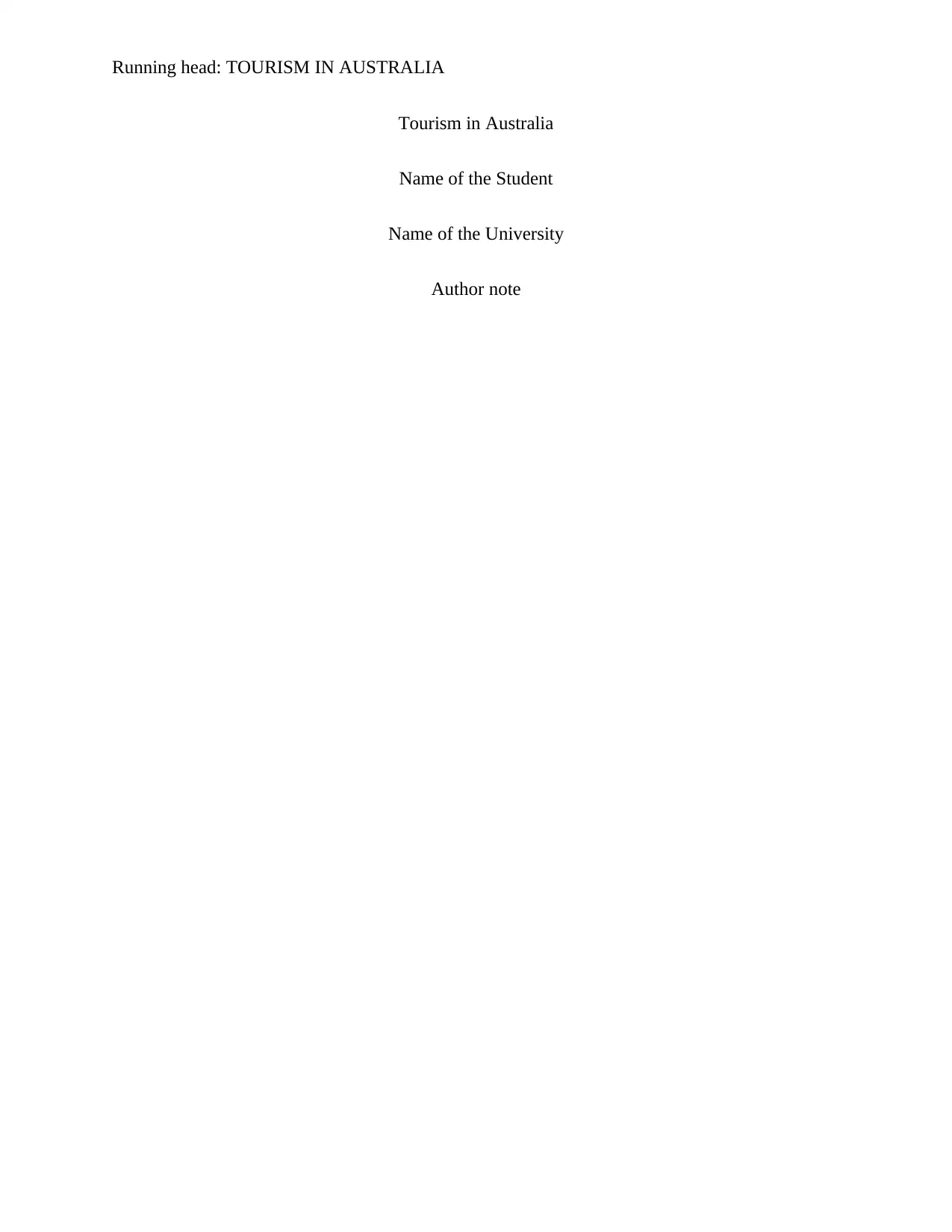
Running head: TOURISM IN AUSTRALIA
Tourism in Australia
Name of the Student
Name of the University
Author note
Tourism in Australia
Name of the Student
Name of the University
Author note
Paraphrase This Document
Need a fresh take? Get an instant paraphrase of this document with our AI Paraphraser
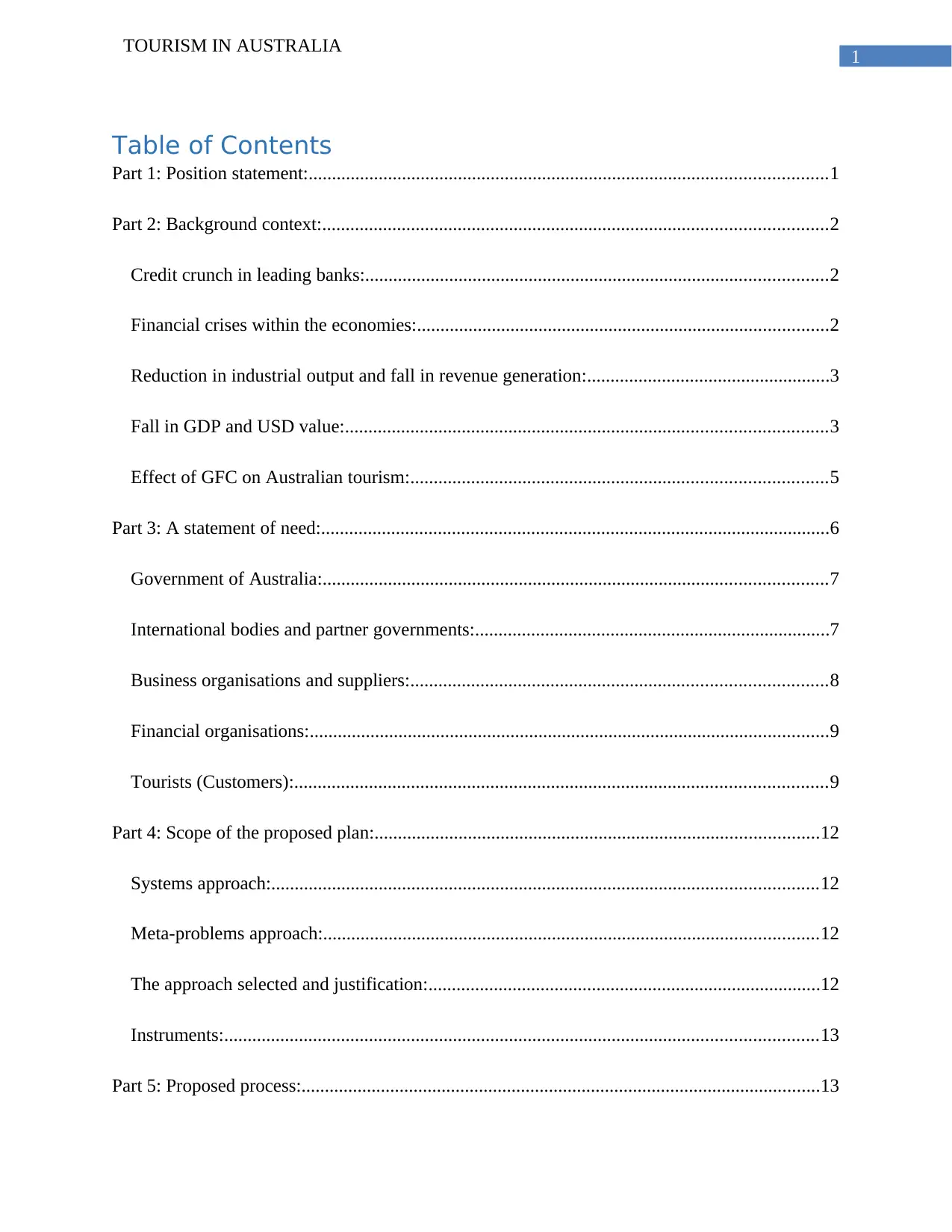
1
TOURISM IN AUSTRALIA
Table of Contents
Part 1: Position statement:...............................................................................................................1
Part 2: Background context:............................................................................................................2
Credit crunch in leading banks:...................................................................................................2
Financial crises within the economies:........................................................................................2
Reduction in industrial output and fall in revenue generation:....................................................3
Fall in GDP and USD value:.......................................................................................................3
Effect of GFC on Australian tourism:.........................................................................................5
Part 3: A statement of need:.............................................................................................................6
Government of Australia:............................................................................................................7
International bodies and partner governments:............................................................................7
Business organisations and suppliers:.........................................................................................8
Financial organisations:...............................................................................................................9
Tourists (Customers):..................................................................................................................9
Part 4: Scope of the proposed plan:...............................................................................................12
Systems approach:.....................................................................................................................12
Meta-problems approach:..........................................................................................................12
The approach selected and justification:....................................................................................12
Instruments:...............................................................................................................................13
Part 5: Proposed process:...............................................................................................................13
TOURISM IN AUSTRALIA
Table of Contents
Part 1: Position statement:...............................................................................................................1
Part 2: Background context:............................................................................................................2
Credit crunch in leading banks:...................................................................................................2
Financial crises within the economies:........................................................................................2
Reduction in industrial output and fall in revenue generation:....................................................3
Fall in GDP and USD value:.......................................................................................................3
Effect of GFC on Australian tourism:.........................................................................................5
Part 3: A statement of need:.............................................................................................................6
Government of Australia:............................................................................................................7
International bodies and partner governments:............................................................................7
Business organisations and suppliers:.........................................................................................8
Financial organisations:...............................................................................................................9
Tourists (Customers):..................................................................................................................9
Part 4: Scope of the proposed plan:...............................................................................................12
Systems approach:.....................................................................................................................12
Meta-problems approach:..........................................................................................................12
The approach selected and justification:....................................................................................12
Instruments:...............................................................................................................................13
Part 5: Proposed process:...............................................................................................................13
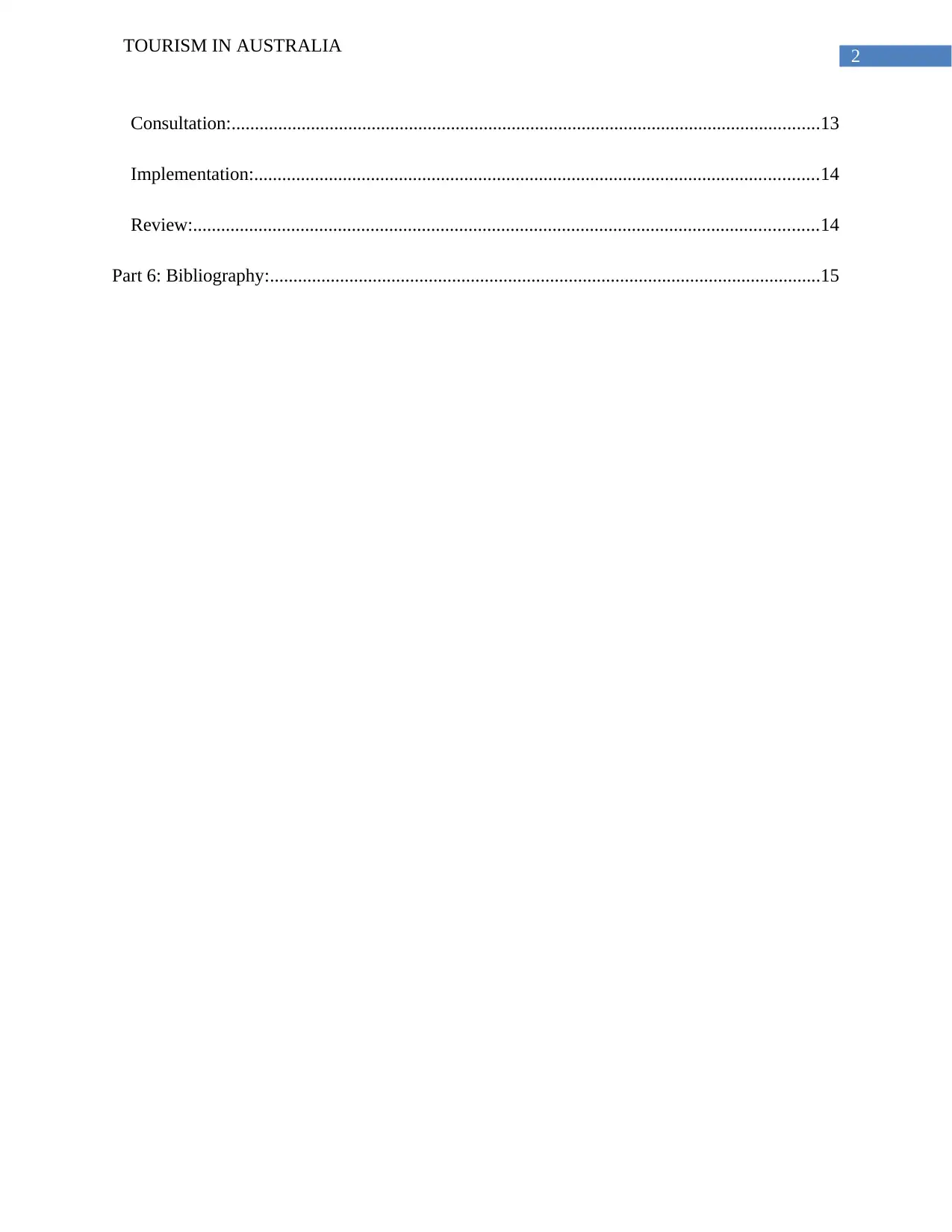
2
TOURISM IN AUSTRALIA
Consultation:..............................................................................................................................13
Implementation:.........................................................................................................................14
Review:......................................................................................................................................14
Part 6: Bibliography:......................................................................................................................15
TOURISM IN AUSTRALIA
Consultation:..............................................................................................................................13
Implementation:.........................................................................................................................14
Review:......................................................................................................................................14
Part 6: Bibliography:......................................................................................................................15
⊘ This is a preview!⊘
Do you want full access?
Subscribe today to unlock all pages.

Trusted by 1+ million students worldwide
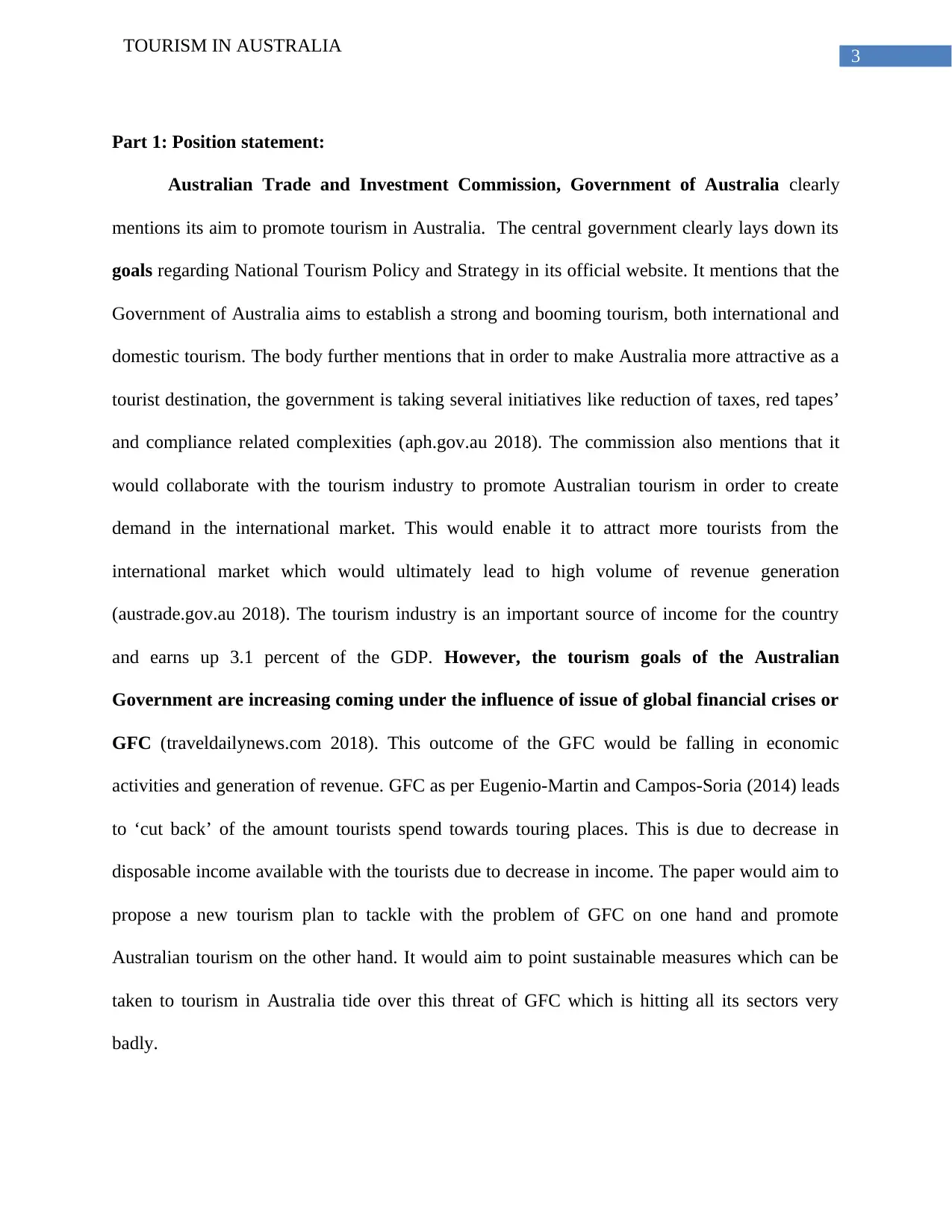
3
TOURISM IN AUSTRALIA
Part 1: Position statement:
Australian Trade and Investment Commission, Government of Australia clearly
mentions its aim to promote tourism in Australia. The central government clearly lays down its
goals regarding National Tourism Policy and Strategy in its official website. It mentions that the
Government of Australia aims to establish a strong and booming tourism, both international and
domestic tourism. The body further mentions that in order to make Australia more attractive as a
tourist destination, the government is taking several initiatives like reduction of taxes, red tapes’
and compliance related complexities (aph.gov.au 2018). The commission also mentions that it
would collaborate with the tourism industry to promote Australian tourism in order to create
demand in the international market. This would enable it to attract more tourists from the
international market which would ultimately lead to high volume of revenue generation
(austrade.gov.au 2018). The tourism industry is an important source of income for the country
and earns up 3.1 percent of the GDP. However, the tourism goals of the Australian
Government are increasing coming under the influence of issue of global financial crises or
GFC (traveldailynews.com 2018). This outcome of the GFC would be falling in economic
activities and generation of revenue. GFC as per Eugenio-Martin and Campos-Soria (2014) leads
to ‘cut back’ of the amount tourists spend towards touring places. This is due to decrease in
disposable income available with the tourists due to decrease in income. The paper would aim to
propose a new tourism plan to tackle with the problem of GFC on one hand and promote
Australian tourism on the other hand. It would aim to point sustainable measures which can be
taken to tourism in Australia tide over this threat of GFC which is hitting all its sectors very
badly.
TOURISM IN AUSTRALIA
Part 1: Position statement:
Australian Trade and Investment Commission, Government of Australia clearly
mentions its aim to promote tourism in Australia. The central government clearly lays down its
goals regarding National Tourism Policy and Strategy in its official website. It mentions that the
Government of Australia aims to establish a strong and booming tourism, both international and
domestic tourism. The body further mentions that in order to make Australia more attractive as a
tourist destination, the government is taking several initiatives like reduction of taxes, red tapes’
and compliance related complexities (aph.gov.au 2018). The commission also mentions that it
would collaborate with the tourism industry to promote Australian tourism in order to create
demand in the international market. This would enable it to attract more tourists from the
international market which would ultimately lead to high volume of revenue generation
(austrade.gov.au 2018). The tourism industry is an important source of income for the country
and earns up 3.1 percent of the GDP. However, the tourism goals of the Australian
Government are increasing coming under the influence of issue of global financial crises or
GFC (traveldailynews.com 2018). This outcome of the GFC would be falling in economic
activities and generation of revenue. GFC as per Eugenio-Martin and Campos-Soria (2014) leads
to ‘cut back’ of the amount tourists spend towards touring places. This is due to decrease in
disposable income available with the tourists due to decrease in income. The paper would aim to
propose a new tourism plan to tackle with the problem of GFC on one hand and promote
Australian tourism on the other hand. It would aim to point sustainable measures which can be
taken to tourism in Australia tide over this threat of GFC which is hitting all its sectors very
badly.
Paraphrase This Document
Need a fresh take? Get an instant paraphrase of this document with our AI Paraphraser
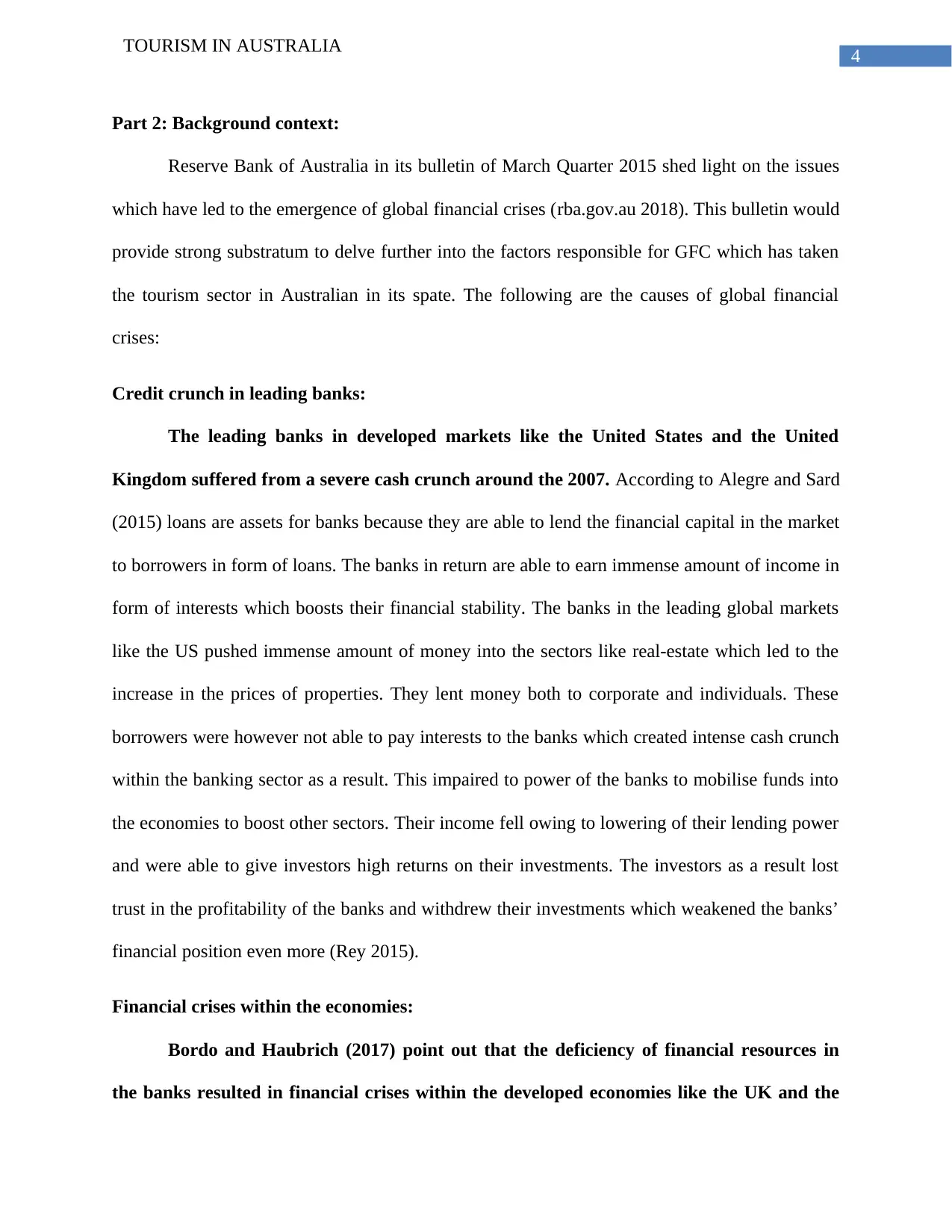
4
TOURISM IN AUSTRALIA
Part 2: Background context:
Reserve Bank of Australia in its bulletin of March Quarter 2015 shed light on the issues
which have led to the emergence of global financial crises (rba.gov.au 2018). This bulletin would
provide strong substratum to delve further into the factors responsible for GFC which has taken
the tourism sector in Australian in its spate. The following are the causes of global financial
crises:
Credit crunch in leading banks:
The leading banks in developed markets like the United States and the United
Kingdom suffered from a severe cash crunch around the 2007. According to Alegre and Sard
(2015) loans are assets for banks because they are able to lend the financial capital in the market
to borrowers in form of loans. The banks in return are able to earn immense amount of income in
form of interests which boosts their financial stability. The banks in the leading global markets
like the US pushed immense amount of money into the sectors like real-estate which led to the
increase in the prices of properties. They lent money both to corporate and individuals. These
borrowers were however not able to pay interests to the banks which created intense cash crunch
within the banking sector as a result. This impaired to power of the banks to mobilise funds into
the economies to boost other sectors. Their income fell owing to lowering of their lending power
and were able to give investors high returns on their investments. The investors as a result lost
trust in the profitability of the banks and withdrew their investments which weakened the banks’
financial position even more (Rey 2015).
Financial crises within the economies:
Bordo and Haubrich (2017) point out that the deficiency of financial resources in
the banks resulted in financial crises within the developed economies like the UK and the
TOURISM IN AUSTRALIA
Part 2: Background context:
Reserve Bank of Australia in its bulletin of March Quarter 2015 shed light on the issues
which have led to the emergence of global financial crises (rba.gov.au 2018). This bulletin would
provide strong substratum to delve further into the factors responsible for GFC which has taken
the tourism sector in Australian in its spate. The following are the causes of global financial
crises:
Credit crunch in leading banks:
The leading banks in developed markets like the United States and the United
Kingdom suffered from a severe cash crunch around the 2007. According to Alegre and Sard
(2015) loans are assets for banks because they are able to lend the financial capital in the market
to borrowers in form of loans. The banks in return are able to earn immense amount of income in
form of interests which boosts their financial stability. The banks in the leading global markets
like the US pushed immense amount of money into the sectors like real-estate which led to the
increase in the prices of properties. They lent money both to corporate and individuals. These
borrowers were however not able to pay interests to the banks which created intense cash crunch
within the banking sector as a result. This impaired to power of the banks to mobilise funds into
the economies to boost other sectors. Their income fell owing to lowering of their lending power
and were able to give investors high returns on their investments. The investors as a result lost
trust in the profitability of the banks and withdrew their investments which weakened the banks’
financial position even more (Rey 2015).
Financial crises within the economies:
Bordo and Haubrich (2017) point out that the deficiency of financial resources in
the banks resulted in financial crises within the developed economies like the UK and the
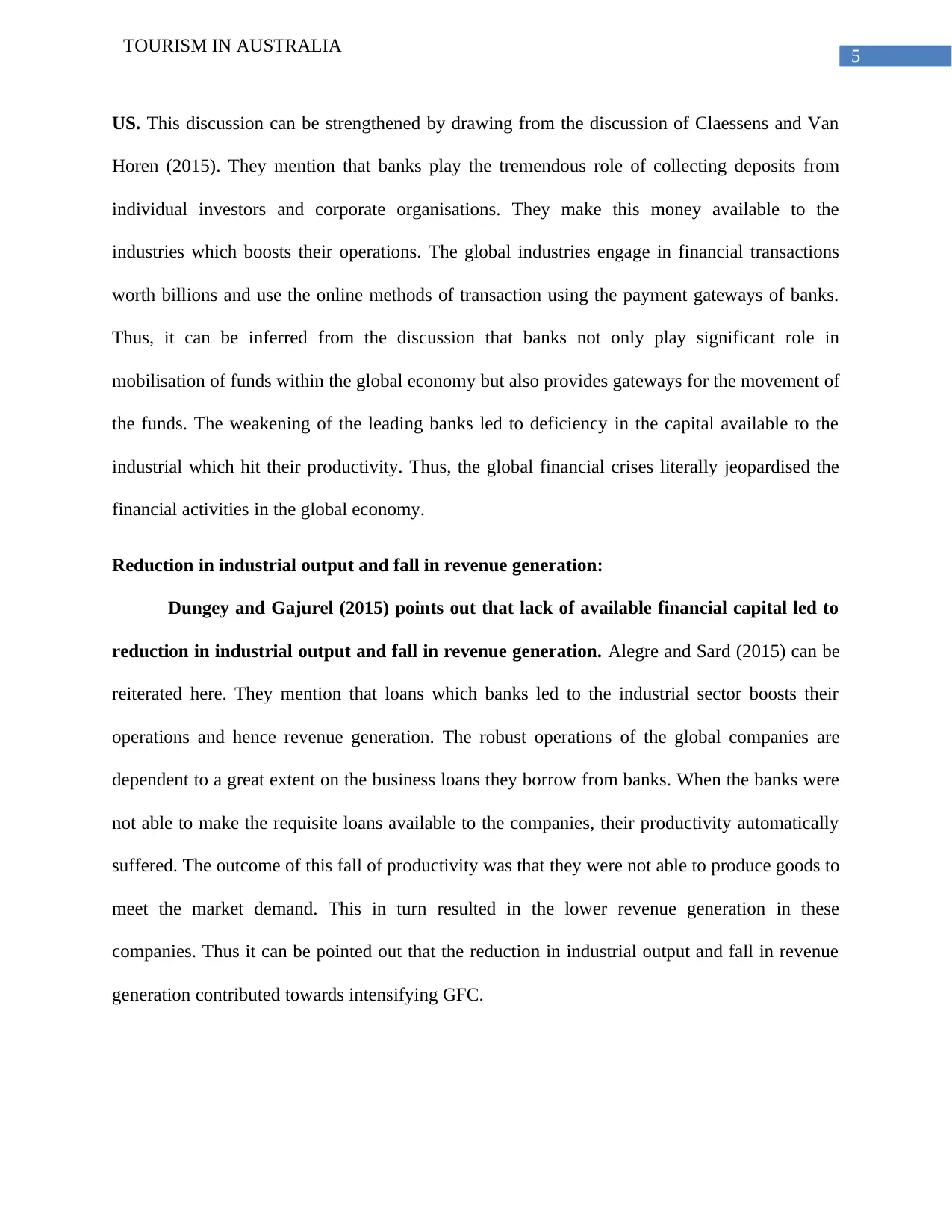
5
TOURISM IN AUSTRALIA
US. This discussion can be strengthened by drawing from the discussion of Claessens and Van
Horen (2015). They mention that banks play the tremendous role of collecting deposits from
individual investors and corporate organisations. They make this money available to the
industries which boosts their operations. The global industries engage in financial transactions
worth billions and use the online methods of transaction using the payment gateways of banks.
Thus, it can be inferred from the discussion that banks not only play significant role in
mobilisation of funds within the global economy but also provides gateways for the movement of
the funds. The weakening of the leading banks led to deficiency in the capital available to the
industrial which hit their productivity. Thus, the global financial crises literally jeopardised the
financial activities in the global economy.
Reduction in industrial output and fall in revenue generation:
Dungey and Gajurel (2015) points out that lack of available financial capital led to
reduction in industrial output and fall in revenue generation. Alegre and Sard (2015) can be
reiterated here. They mention that loans which banks led to the industrial sector boosts their
operations and hence revenue generation. The robust operations of the global companies are
dependent to a great extent on the business loans they borrow from banks. When the banks were
not able to make the requisite loans available to the companies, their productivity automatically
suffered. The outcome of this fall of productivity was that they were not able to produce goods to
meet the market demand. This in turn resulted in the lower revenue generation in these
companies. Thus it can be pointed out that the reduction in industrial output and fall in revenue
generation contributed towards intensifying GFC.
TOURISM IN AUSTRALIA
US. This discussion can be strengthened by drawing from the discussion of Claessens and Van
Horen (2015). They mention that banks play the tremendous role of collecting deposits from
individual investors and corporate organisations. They make this money available to the
industries which boosts their operations. The global industries engage in financial transactions
worth billions and use the online methods of transaction using the payment gateways of banks.
Thus, it can be inferred from the discussion that banks not only play significant role in
mobilisation of funds within the global economy but also provides gateways for the movement of
the funds. The weakening of the leading banks led to deficiency in the capital available to the
industrial which hit their productivity. Thus, the global financial crises literally jeopardised the
financial activities in the global economy.
Reduction in industrial output and fall in revenue generation:
Dungey and Gajurel (2015) points out that lack of available financial capital led to
reduction in industrial output and fall in revenue generation. Alegre and Sard (2015) can be
reiterated here. They mention that loans which banks led to the industrial sector boosts their
operations and hence revenue generation. The robust operations of the global companies are
dependent to a great extent on the business loans they borrow from banks. When the banks were
not able to make the requisite loans available to the companies, their productivity automatically
suffered. The outcome of this fall of productivity was that they were not able to produce goods to
meet the market demand. This in turn resulted in the lower revenue generation in these
companies. Thus it can be pointed out that the reduction in industrial output and fall in revenue
generation contributed towards intensifying GFC.
⊘ This is a preview!⊘
Do you want full access?
Subscribe today to unlock all pages.

Trusted by 1+ million students worldwide
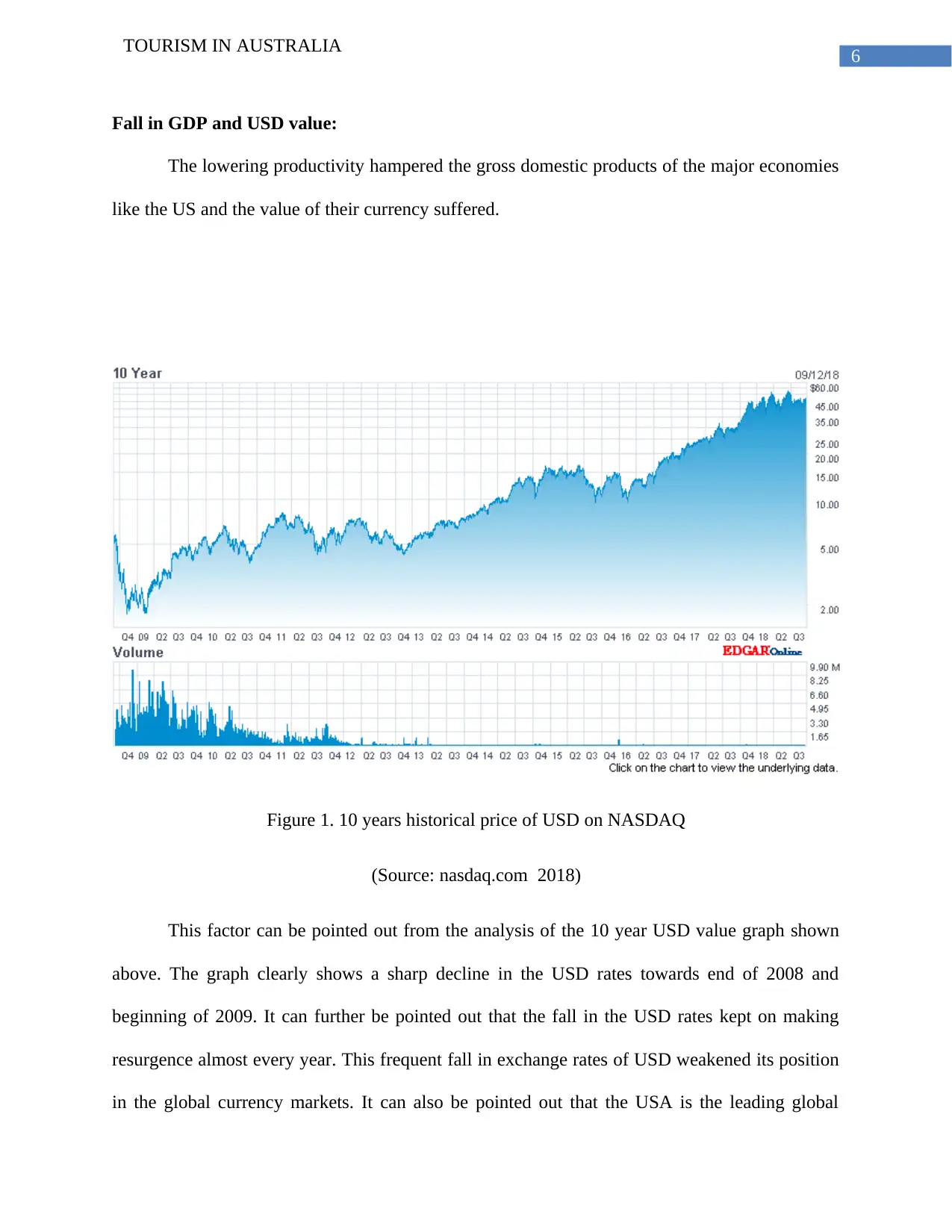
6
TOURISM IN AUSTRALIA
Fall in GDP and USD value:
The lowering productivity hampered the gross domestic products of the major economies
like the US and the value of their currency suffered.
Figure 1. 10 years historical price of USD on NASDAQ
(Source: nasdaq.com 2018)
This factor can be pointed out from the analysis of the 10 year USD value graph shown
above. The graph clearly shows a sharp decline in the USD rates towards end of 2008 and
beginning of 2009. It can further be pointed out that the fall in the USD rates kept on making
resurgence almost every year. This frequent fall in exchange rates of USD weakened its position
in the global currency markets. It can also be pointed out that the USA is the leading global
TOURISM IN AUSTRALIA
Fall in GDP and USD value:
The lowering productivity hampered the gross domestic products of the major economies
like the US and the value of their currency suffered.
Figure 1. 10 years historical price of USD on NASDAQ
(Source: nasdaq.com 2018)
This factor can be pointed out from the analysis of the 10 year USD value graph shown
above. The graph clearly shows a sharp decline in the USD rates towards end of 2008 and
beginning of 2009. It can further be pointed out that the fall in the USD rates kept on making
resurgence almost every year. This frequent fall in exchange rates of USD weakened its position
in the global currency markets. It can also be pointed out that the USA is the leading global
Paraphrase This Document
Need a fresh take? Get an instant paraphrase of this document with our AI Paraphraser
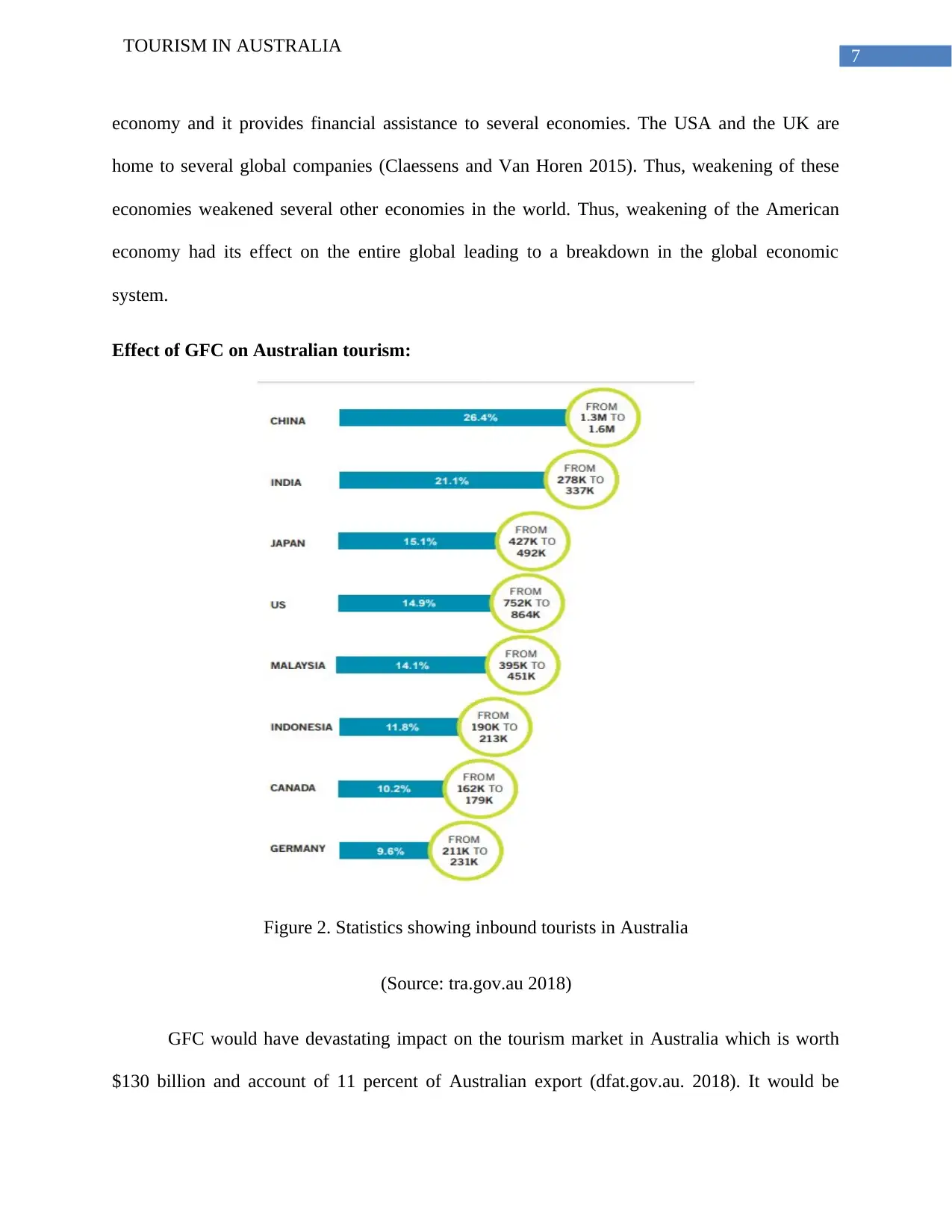
7
TOURISM IN AUSTRALIA
economy and it provides financial assistance to several economies. The USA and the UK are
home to several global companies (Claessens and Van Horen 2015). Thus, weakening of these
economies weakened several other economies in the world. Thus, weakening of the American
economy had its effect on the entire global leading to a breakdown in the global economic
system.
Effect of GFC on Australian tourism:
Figure 2. Statistics showing inbound tourists in Australia
(Source: tra.gov.au 2018)
GFC would have devastating impact on the tourism market in Australia which is worth
$130 billion and account of 11 percent of Australian export (dfat.gov.au. 2018). It would be
TOURISM IN AUSTRALIA
economy and it provides financial assistance to several economies. The USA and the UK are
home to several global companies (Claessens and Van Horen 2015). Thus, weakening of these
economies weakened several other economies in the world. Thus, weakening of the American
economy had its effect on the entire global leading to a breakdown in the global economic
system.
Effect of GFC on Australian tourism:
Figure 2. Statistics showing inbound tourists in Australia
(Source: tra.gov.au 2018)
GFC would have devastating impact on the tourism market in Australia which is worth
$130 billion and account of 11 percent of Australian export (dfat.gov.au. 2018). It would be
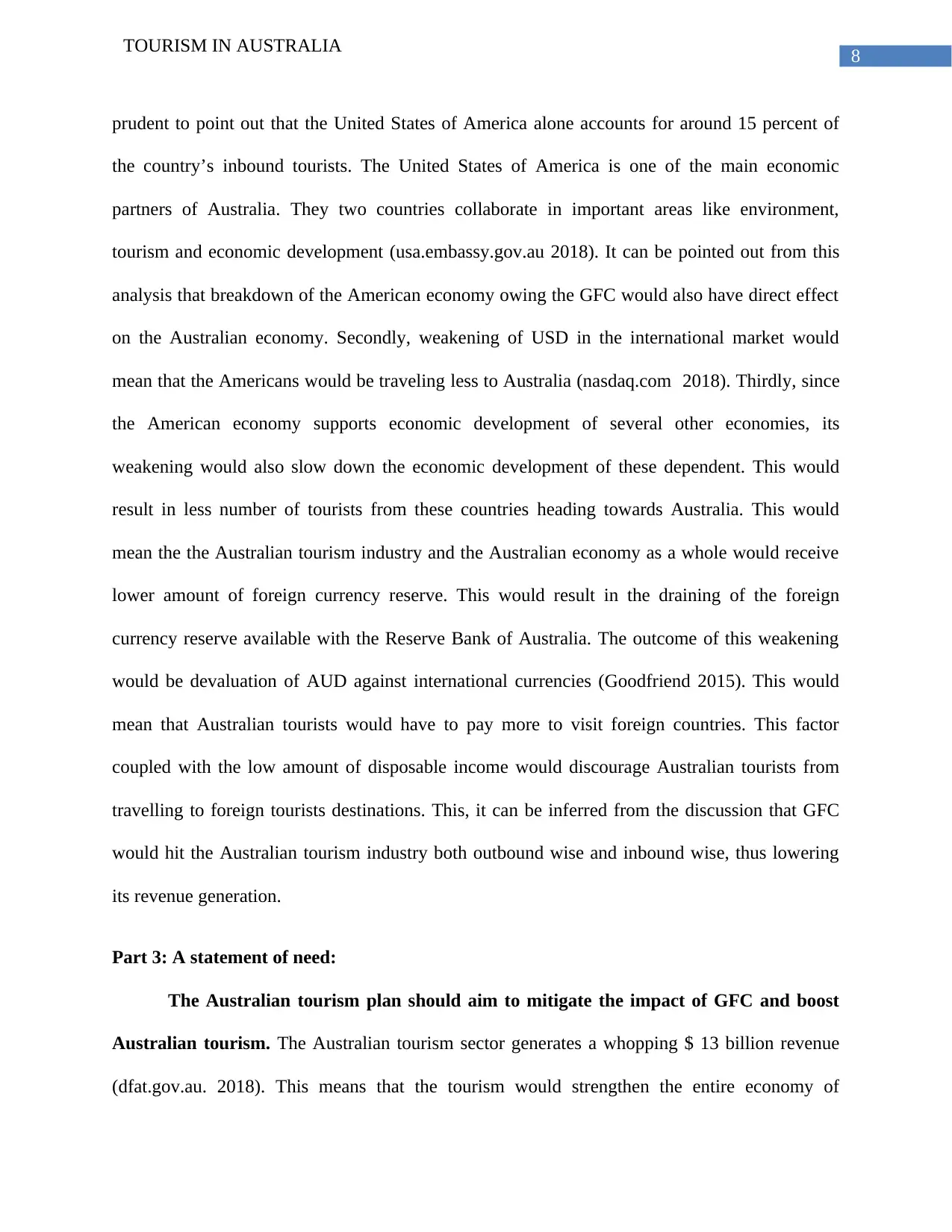
8
TOURISM IN AUSTRALIA
prudent to point out that the United States of America alone accounts for around 15 percent of
the country’s inbound tourists. The United States of America is one of the main economic
partners of Australia. They two countries collaborate in important areas like environment,
tourism and economic development (usa.embassy.gov.au 2018). It can be pointed out from this
analysis that breakdown of the American economy owing the GFC would also have direct effect
on the Australian economy. Secondly, weakening of USD in the international market would
mean that the Americans would be traveling less to Australia (nasdaq.com 2018). Thirdly, since
the American economy supports economic development of several other economies, its
weakening would also slow down the economic development of these dependent. This would
result in less number of tourists from these countries heading towards Australia. This would
mean the the Australian tourism industry and the Australian economy as a whole would receive
lower amount of foreign currency reserve. This would result in the draining of the foreign
currency reserve available with the Reserve Bank of Australia. The outcome of this weakening
would be devaluation of AUD against international currencies (Goodfriend 2015). This would
mean that Australian tourists would have to pay more to visit foreign countries. This factor
coupled with the low amount of disposable income would discourage Australian tourists from
travelling to foreign tourists destinations. This, it can be inferred from the discussion that GFC
would hit the Australian tourism industry both outbound wise and inbound wise, thus lowering
its revenue generation.
Part 3: A statement of need:
The Australian tourism plan should aim to mitigate the impact of GFC and boost
Australian tourism. The Australian tourism sector generates a whopping $ 13 billion revenue
(dfat.gov.au. 2018). This means that the tourism would strengthen the entire economy of
TOURISM IN AUSTRALIA
prudent to point out that the United States of America alone accounts for around 15 percent of
the country’s inbound tourists. The United States of America is one of the main economic
partners of Australia. They two countries collaborate in important areas like environment,
tourism and economic development (usa.embassy.gov.au 2018). It can be pointed out from this
analysis that breakdown of the American economy owing the GFC would also have direct effect
on the Australian economy. Secondly, weakening of USD in the international market would
mean that the Americans would be traveling less to Australia (nasdaq.com 2018). Thirdly, since
the American economy supports economic development of several other economies, its
weakening would also slow down the economic development of these dependent. This would
result in less number of tourists from these countries heading towards Australia. This would
mean the the Australian tourism industry and the Australian economy as a whole would receive
lower amount of foreign currency reserve. This would result in the draining of the foreign
currency reserve available with the Reserve Bank of Australia. The outcome of this weakening
would be devaluation of AUD against international currencies (Goodfriend 2015). This would
mean that Australian tourists would have to pay more to visit foreign countries. This factor
coupled with the low amount of disposable income would discourage Australian tourists from
travelling to foreign tourists destinations. This, it can be inferred from the discussion that GFC
would hit the Australian tourism industry both outbound wise and inbound wise, thus lowering
its revenue generation.
Part 3: A statement of need:
The Australian tourism plan should aim to mitigate the impact of GFC and boost
Australian tourism. The Australian tourism sector generates a whopping $ 13 billion revenue
(dfat.gov.au. 2018). This means that the tourism would strengthen the entire economy of
⊘ This is a preview!⊘
Do you want full access?
Subscribe today to unlock all pages.

Trusted by 1+ million students worldwide
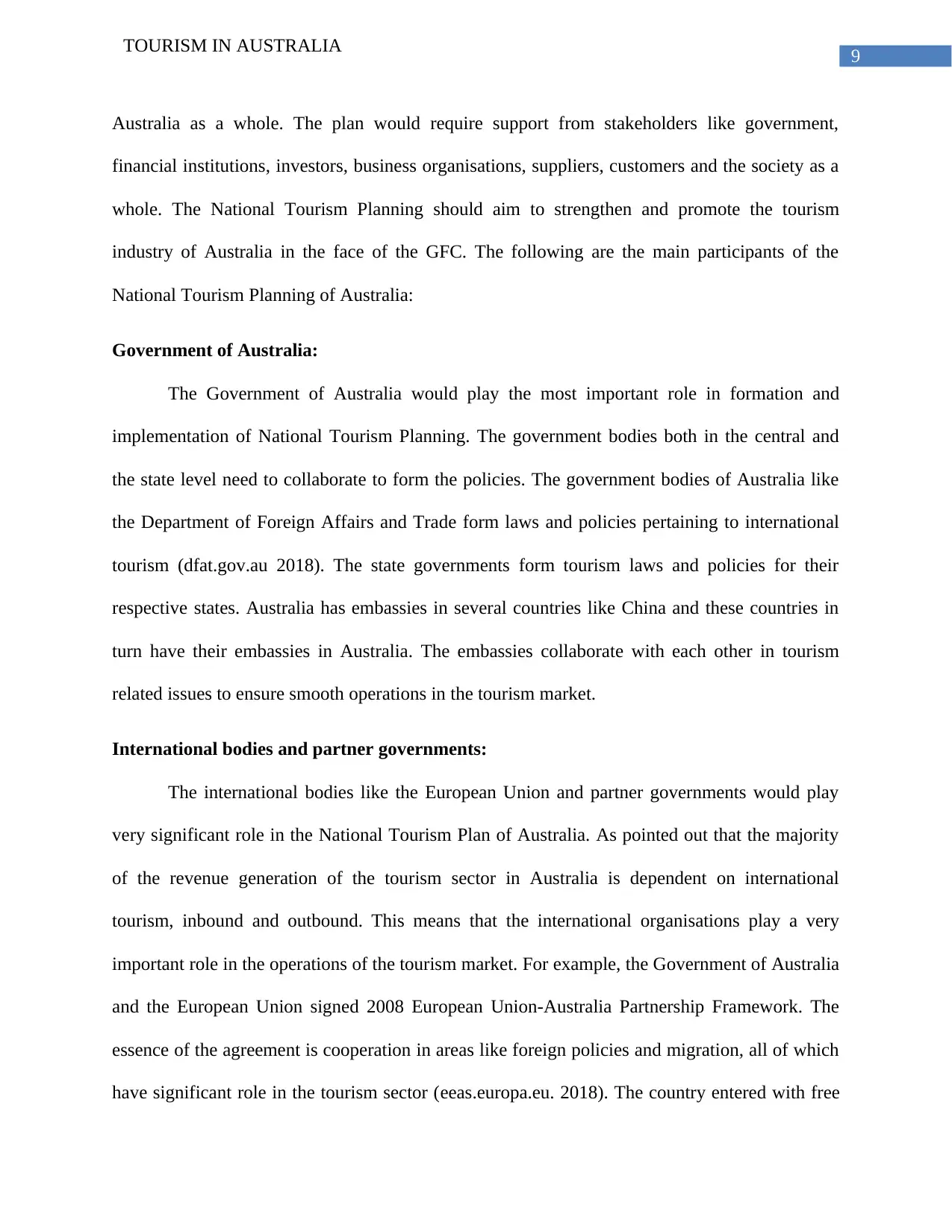
9
TOURISM IN AUSTRALIA
Australia as a whole. The plan would require support from stakeholders like government,
financial institutions, investors, business organisations, suppliers, customers and the society as a
whole. The National Tourism Planning should aim to strengthen and promote the tourism
industry of Australia in the face of the GFC. The following are the main participants of the
National Tourism Planning of Australia:
Government of Australia:
The Government of Australia would play the most important role in formation and
implementation of National Tourism Planning. The government bodies both in the central and
the state level need to collaborate to form the policies. The government bodies of Australia like
the Department of Foreign Affairs and Trade form laws and policies pertaining to international
tourism (dfat.gov.au 2018). The state governments form tourism laws and policies for their
respective states. Australia has embassies in several countries like China and these countries in
turn have their embassies in Australia. The embassies collaborate with each other in tourism
related issues to ensure smooth operations in the tourism market.
International bodies and partner governments:
The international bodies like the European Union and partner governments would play
very significant role in the National Tourism Plan of Australia. As pointed out that the majority
of the revenue generation of the tourism sector in Australia is dependent on international
tourism, inbound and outbound. This means that the international organisations play a very
important role in the operations of the tourism market. For example, the Government of Australia
and the European Union signed 2008 European Union-Australia Partnership Framework. The
essence of the agreement is cooperation in areas like foreign policies and migration, all of which
have significant role in the tourism sector (eeas.europa.eu. 2018). The country entered with free
TOURISM IN AUSTRALIA
Australia as a whole. The plan would require support from stakeholders like government,
financial institutions, investors, business organisations, suppliers, customers and the society as a
whole. The National Tourism Planning should aim to strengthen and promote the tourism
industry of Australia in the face of the GFC. The following are the main participants of the
National Tourism Planning of Australia:
Government of Australia:
The Government of Australia would play the most important role in formation and
implementation of National Tourism Planning. The government bodies both in the central and
the state level need to collaborate to form the policies. The government bodies of Australia like
the Department of Foreign Affairs and Trade form laws and policies pertaining to international
tourism (dfat.gov.au 2018). The state governments form tourism laws and policies for their
respective states. Australia has embassies in several countries like China and these countries in
turn have their embassies in Australia. The embassies collaborate with each other in tourism
related issues to ensure smooth operations in the tourism market.
International bodies and partner governments:
The international bodies like the European Union and partner governments would play
very significant role in the National Tourism Plan of Australia. As pointed out that the majority
of the revenue generation of the tourism sector in Australia is dependent on international
tourism, inbound and outbound. This means that the international organisations play a very
important role in the operations of the tourism market. For example, the Government of Australia
and the European Union signed 2008 European Union-Australia Partnership Framework. The
essence of the agreement is cooperation in areas like foreign policies and migration, all of which
have significant role in the tourism sector (eeas.europa.eu. 2018). The country entered with free
Paraphrase This Document
Need a fresh take? Get an instant paraphrase of this document with our AI Paraphraser
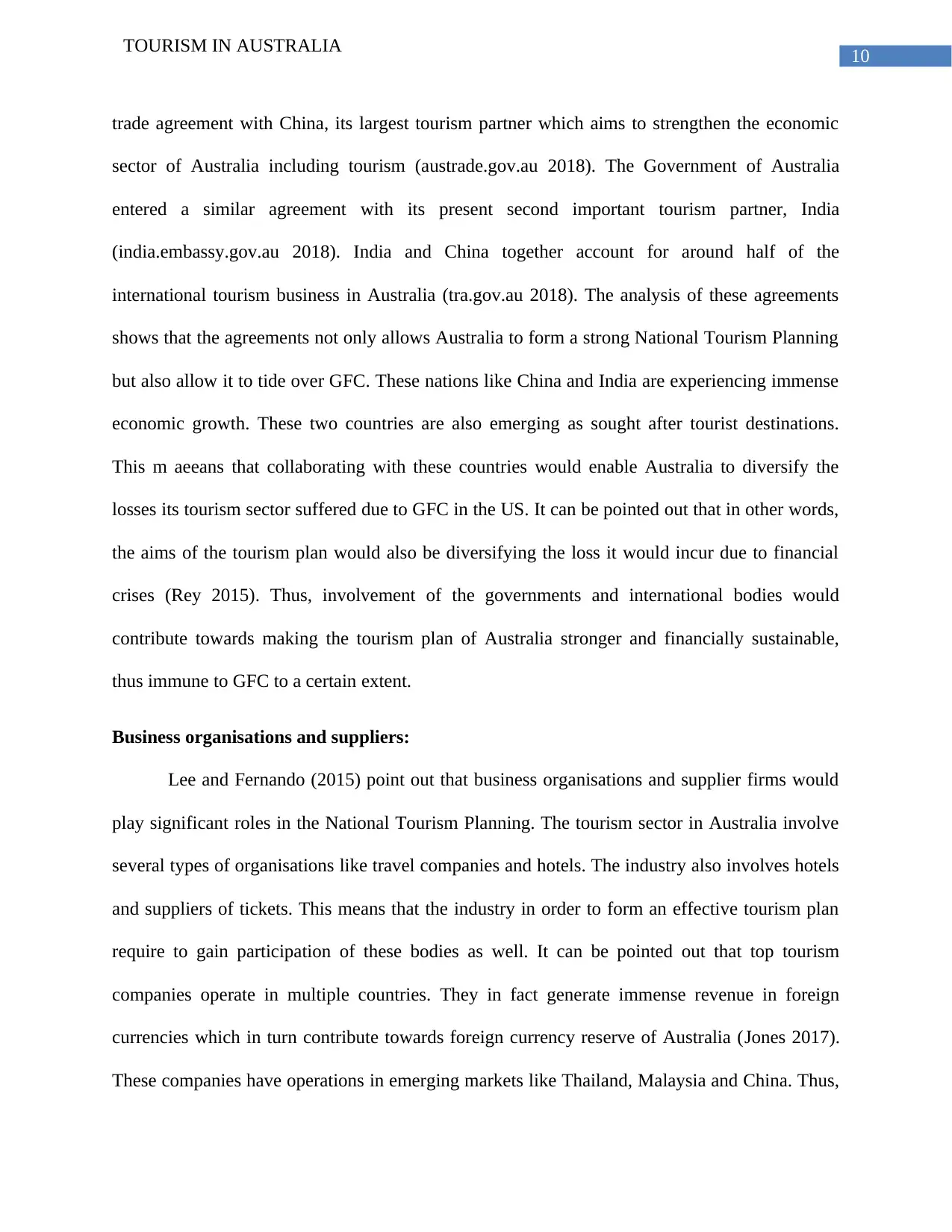
10
TOURISM IN AUSTRALIA
trade agreement with China, its largest tourism partner which aims to strengthen the economic
sector of Australia including tourism (austrade.gov.au 2018). The Government of Australia
entered a similar agreement with its present second important tourism partner, India
(india.embassy.gov.au 2018). India and China together account for around half of the
international tourism business in Australia (tra.gov.au 2018). The analysis of these agreements
shows that the agreements not only allows Australia to form a strong National Tourism Planning
but also allow it to tide over GFC. These nations like China and India are experiencing immense
economic growth. These two countries are also emerging as sought after tourist destinations.
This m aeeans that collaborating with these countries would enable Australia to diversify the
losses its tourism sector suffered due to GFC in the US. It can be pointed out that in other words,
the aims of the tourism plan would also be diversifying the loss it would incur due to financial
crises (Rey 2015). Thus, involvement of the governments and international bodies would
contribute towards making the tourism plan of Australia stronger and financially sustainable,
thus immune to GFC to a certain extent.
Business organisations and suppliers:
Lee and Fernando (2015) point out that business organisations and supplier firms would
play significant roles in the National Tourism Planning. The tourism sector in Australia involve
several types of organisations like travel companies and hotels. The industry also involves hotels
and suppliers of tickets. This means that the industry in order to form an effective tourism plan
require to gain participation of these bodies as well. It can be pointed out that top tourism
companies operate in multiple countries. They in fact generate immense revenue in foreign
currencies which in turn contribute towards foreign currency reserve of Australia (Jones 2017).
These companies have operations in emerging markets like Thailand, Malaysia and China. Thus,
TOURISM IN AUSTRALIA
trade agreement with China, its largest tourism partner which aims to strengthen the economic
sector of Australia including tourism (austrade.gov.au 2018). The Government of Australia
entered a similar agreement with its present second important tourism partner, India
(india.embassy.gov.au 2018). India and China together account for around half of the
international tourism business in Australia (tra.gov.au 2018). The analysis of these agreements
shows that the agreements not only allows Australia to form a strong National Tourism Planning
but also allow it to tide over GFC. These nations like China and India are experiencing immense
economic growth. These two countries are also emerging as sought after tourist destinations.
This m aeeans that collaborating with these countries would enable Australia to diversify the
losses its tourism sector suffered due to GFC in the US. It can be pointed out that in other words,
the aims of the tourism plan would also be diversifying the loss it would incur due to financial
crises (Rey 2015). Thus, involvement of the governments and international bodies would
contribute towards making the tourism plan of Australia stronger and financially sustainable,
thus immune to GFC to a certain extent.
Business organisations and suppliers:
Lee and Fernando (2015) point out that business organisations and supplier firms would
play significant roles in the National Tourism Planning. The tourism sector in Australia involve
several types of organisations like travel companies and hotels. The industry also involves hotels
and suppliers of tickets. This means that the industry in order to form an effective tourism plan
require to gain participation of these bodies as well. It can be pointed out that top tourism
companies operate in multiple countries. They in fact generate immense revenue in foreign
currencies which in turn contribute towards foreign currency reserve of Australia (Jones 2017).
These companies have operations in emerging markets like Thailand, Malaysia and China. Thus,
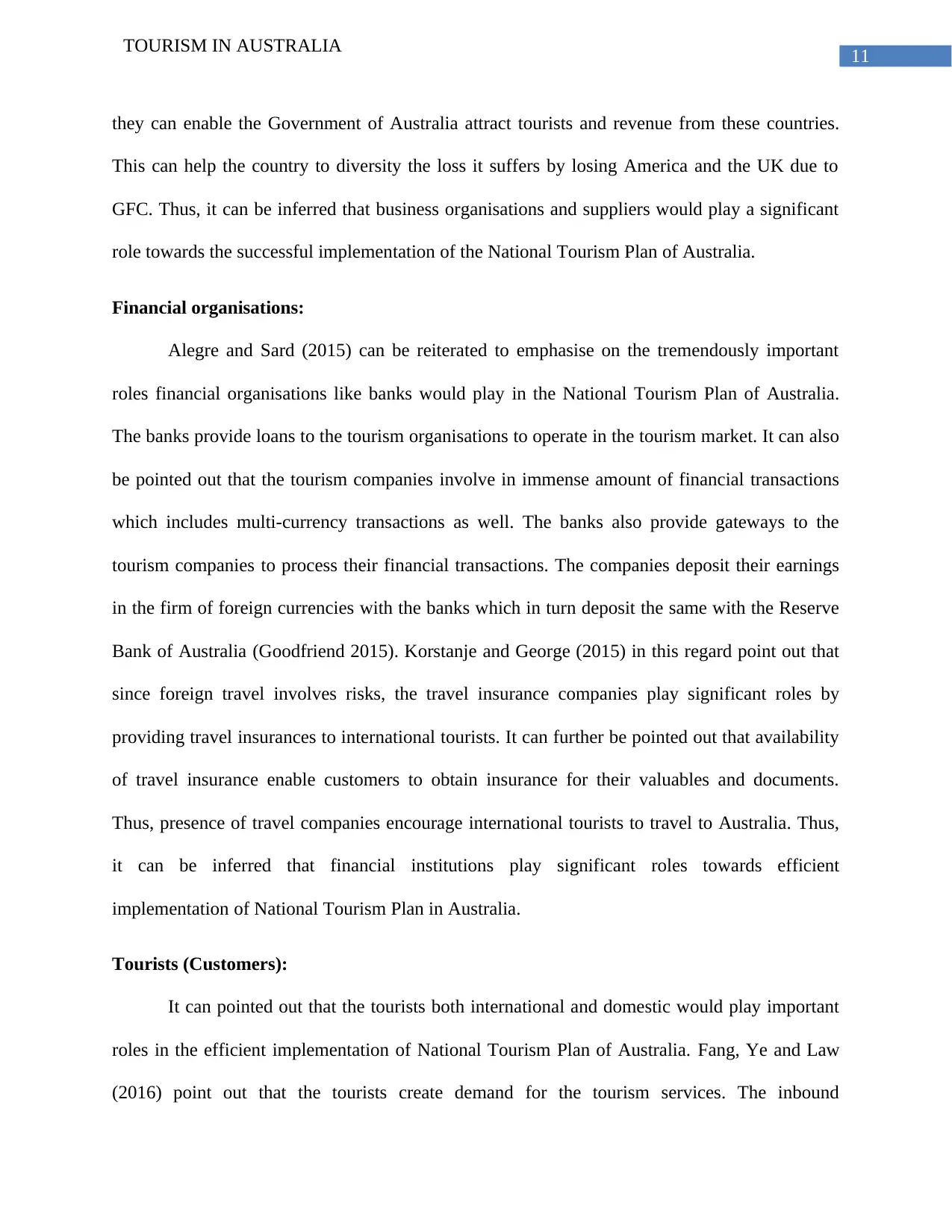
11
TOURISM IN AUSTRALIA
they can enable the Government of Australia attract tourists and revenue from these countries.
This can help the country to diversity the loss it suffers by losing America and the UK due to
GFC. Thus, it can be inferred that business organisations and suppliers would play a significant
role towards the successful implementation of the National Tourism Plan of Australia.
Financial organisations:
Alegre and Sard (2015) can be reiterated to emphasise on the tremendously important
roles financial organisations like banks would play in the National Tourism Plan of Australia.
The banks provide loans to the tourism organisations to operate in the tourism market. It can also
be pointed out that the tourism companies involve in immense amount of financial transactions
which includes multi-currency transactions as well. The banks also provide gateways to the
tourism companies to process their financial transactions. The companies deposit their earnings
in the firm of foreign currencies with the banks which in turn deposit the same with the Reserve
Bank of Australia (Goodfriend 2015). Korstanje and George (2015) in this regard point out that
since foreign travel involves risks, the travel insurance companies play significant roles by
providing travel insurances to international tourists. It can further be pointed out that availability
of travel insurance enable customers to obtain insurance for their valuables and documents.
Thus, presence of travel companies encourage international tourists to travel to Australia. Thus,
it can be inferred that financial institutions play significant roles towards efficient
implementation of National Tourism Plan in Australia.
Tourists (Customers):
It can pointed out that the tourists both international and domestic would play important
roles in the efficient implementation of National Tourism Plan of Australia. Fang, Ye and Law
(2016) point out that the tourists create demand for the tourism services. The inbound
TOURISM IN AUSTRALIA
they can enable the Government of Australia attract tourists and revenue from these countries.
This can help the country to diversity the loss it suffers by losing America and the UK due to
GFC. Thus, it can be inferred that business organisations and suppliers would play a significant
role towards the successful implementation of the National Tourism Plan of Australia.
Financial organisations:
Alegre and Sard (2015) can be reiterated to emphasise on the tremendously important
roles financial organisations like banks would play in the National Tourism Plan of Australia.
The banks provide loans to the tourism organisations to operate in the tourism market. It can also
be pointed out that the tourism companies involve in immense amount of financial transactions
which includes multi-currency transactions as well. The banks also provide gateways to the
tourism companies to process their financial transactions. The companies deposit their earnings
in the firm of foreign currencies with the banks which in turn deposit the same with the Reserve
Bank of Australia (Goodfriend 2015). Korstanje and George (2015) in this regard point out that
since foreign travel involves risks, the travel insurance companies play significant roles by
providing travel insurances to international tourists. It can further be pointed out that availability
of travel insurance enable customers to obtain insurance for their valuables and documents.
Thus, presence of travel companies encourage international tourists to travel to Australia. Thus,
it can be inferred that financial institutions play significant roles towards efficient
implementation of National Tourism Plan in Australia.
Tourists (Customers):
It can pointed out that the tourists both international and domestic would play important
roles in the efficient implementation of National Tourism Plan of Australia. Fang, Ye and Law
(2016) point out that the tourists create demand for the tourism services. The inbound
⊘ This is a preview!⊘
Do you want full access?
Subscribe today to unlock all pages.

Trusted by 1+ million students worldwide
1 out of 20
Related Documents
Your All-in-One AI-Powered Toolkit for Academic Success.
+13062052269
info@desklib.com
Available 24*7 on WhatsApp / Email
![[object Object]](/_next/static/media/star-bottom.7253800d.svg)
Unlock your academic potential
Copyright © 2020–2025 A2Z Services. All Rights Reserved. Developed and managed by ZUCOL.



